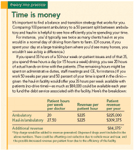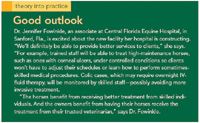The road ahead: staying put
Changes in horse owners' expectations clear a path for better working conditions?and may let you dedicate more time to your patients.
Envision The Life Of An Equine Veterinarian. Do you see a truck and a lone individual spending days and sometimes nights on the road driving from barn to barn? Long days, no personal life—the modern day version of the Lone Ranger?
Aside from the veterinarians who work with large specialty or surgical hospitals, this is what most equine practitioners assume working with horses is all about. Not all clients have trailers, so you need to hit the road. Or do you?
Your client base is changing
The largest growing segment of new horse owners consists of women older than 35 who have the time and money to realize their dreams of owning a horse. Look at the Bayer Select World Championship Show—a full-schedule, stand-alone show for the 50-and-older competitors.
Select classes rank among the most competitive at a typical Quarter Horse show, because riders want to accumulate enough points to participate in the select show. The breed shows all now boast full divisions for the 35-and-older and 50-and-older crowds. The hunter/jumper shows also provide divisions for mature riders, and their numbers continue to grow. In fact, sometimes these are larger divisions than the youth and amateur classes.
This trend is important to you, because this group's going to make up a bigger portion of your client base. And members of this population generally have big demands on their time. They also tend to be well-educated and Internet savvy—and they want and demand what's best for their horses.
This client could change your practice
It used to be that you told your clients you'd be at their farm Tuesday morning before noon. Assuming nothing disrupted your schedule, you got there Tuesday morning, took care of the horse, and went on about your day. If your patient had a problem requiring treatment several times during the day, you left instructions, and it was up to your client to see that they were carried out. If your patient required blood work or specialized equipment you didn't have on your truck, you simply scheduled another appointment. What's wrong with this picture?
Many of your clients juggle demanding personal schedules. Yes, they have time to own a horse, but they don't have time to wait at the barn for you. Nor can they spend all day soaking legs, putting on ointment, or providing other medical care their horses may need.
Plus, many of them have trailers or backup transportation arrangements and could bring their horse to your facility. There you have the equipment at your fingertips and the support you need to do a complete and thorough workup on the horse without needing so many follow-up visits.
Dr. Andy Bennett, a sole practitioner with Polk Equine, P.L., in central Florida, believes if he had less "windshield" time he'd have more time to devote to treating the difficult cases that he sees in his practice. He believes that he could add newer and better services for his clients. Even if his practice income takes a dip at first, which he believes it will, he says it's worth it. In the long run his patients will benefit from being able to come to a facility where the working conditions are better.
At the practice, you generally enjoy nicer working conditions than what you find at clients' barns. You'll have good lighting, a concrete surface on which to check for lameness, stocks if you need them, the right electrical hookup for your radiograph machine, and so on.
Busy clients appreciate that they can bring their horses to you on a specific day, at an appointment time, and they stand a good chance of their horses being seen and treated efficiently. If their horses need follow-up care that would require them to take off time from work or away from other things they need to do in order to try to administer it at home, they'll be willing to pay for the service. They're happy to leave their horses at your office where they'll get the care they need.

Time is money
You don't have to go all in
Are you going to be able to give up the ambulatory side of your practice? Probably not. Will it work for enough of your clients to justify the expense of building and equipping a haul-in facility, if you don't have one now? Maybe. The first step to answering this question is to ask clients what they want. If clients seem open to hauling in, talk to your accountant and/or consultant about what such an undertaking would cost and then do a feasibility study to see whether it makes sense.
Dr. Dehaven Batchelor, owner of Central Florida Equine Hospital, says now that they have the option, their clients bring their horses to them rather than have them visit their barns. Many of their clients regularly take their horses to shows, lessons, trail rides, or other events, so they're used to hauling.
The practice services a five-county area and clients found the approach disrupts their busy lives less, and their animals are seen faster and receive better care. (After all, five counties is a lot of territory to cover.)
Dr. Batchelor believes he receives a much better return on the investment they made in equipment by seeing more patients under the controlled conditions of their facility.

Good outlook
Still more benefits
What other benefits would such a facility bring to your practice? Well, for starters, this approach could make your practice more attractive to potential associates, which could help your ownership transition plan.
The younger generation doesn't want to be on the road all the time. And hauling around radiograph machines and ultrasounds is hard work. Plus, the barns don't always offer ideal conditions to use the equipment anyway.
Another benefit: increased efficiency for your business. "But I'll lose all the farm call income I'm receiving now," you say. Do you really think the amount you're making from farm calls is worth the time and money you'd save not driving around? If you do, talk to your accountant. He or she can show you what your real realized income rate is for treating patients versus drive time.
So ideally this approach means you can see more patients more efficiently and effectively. And you'll attract clientele willing to pay for your services because your facilities are catering to their need for more efficient use of their time and resources. In short, a haul-in facility holds the key for better services to your patients—and you could get paid better for the great care you provide.
Elise Lacher, CPA, is a consultant with Lacher, McDonald Consulting in Seminole, Fla.